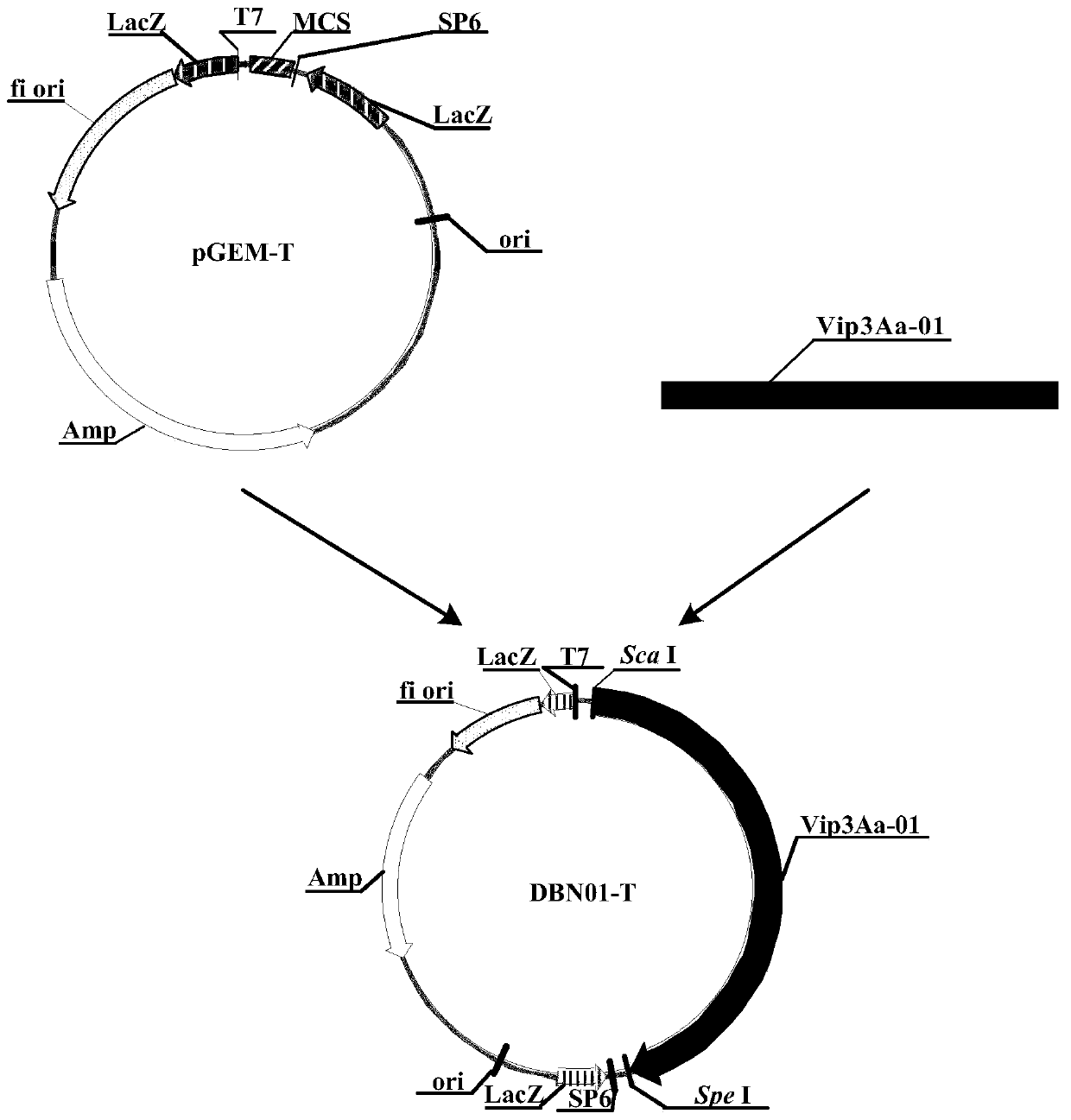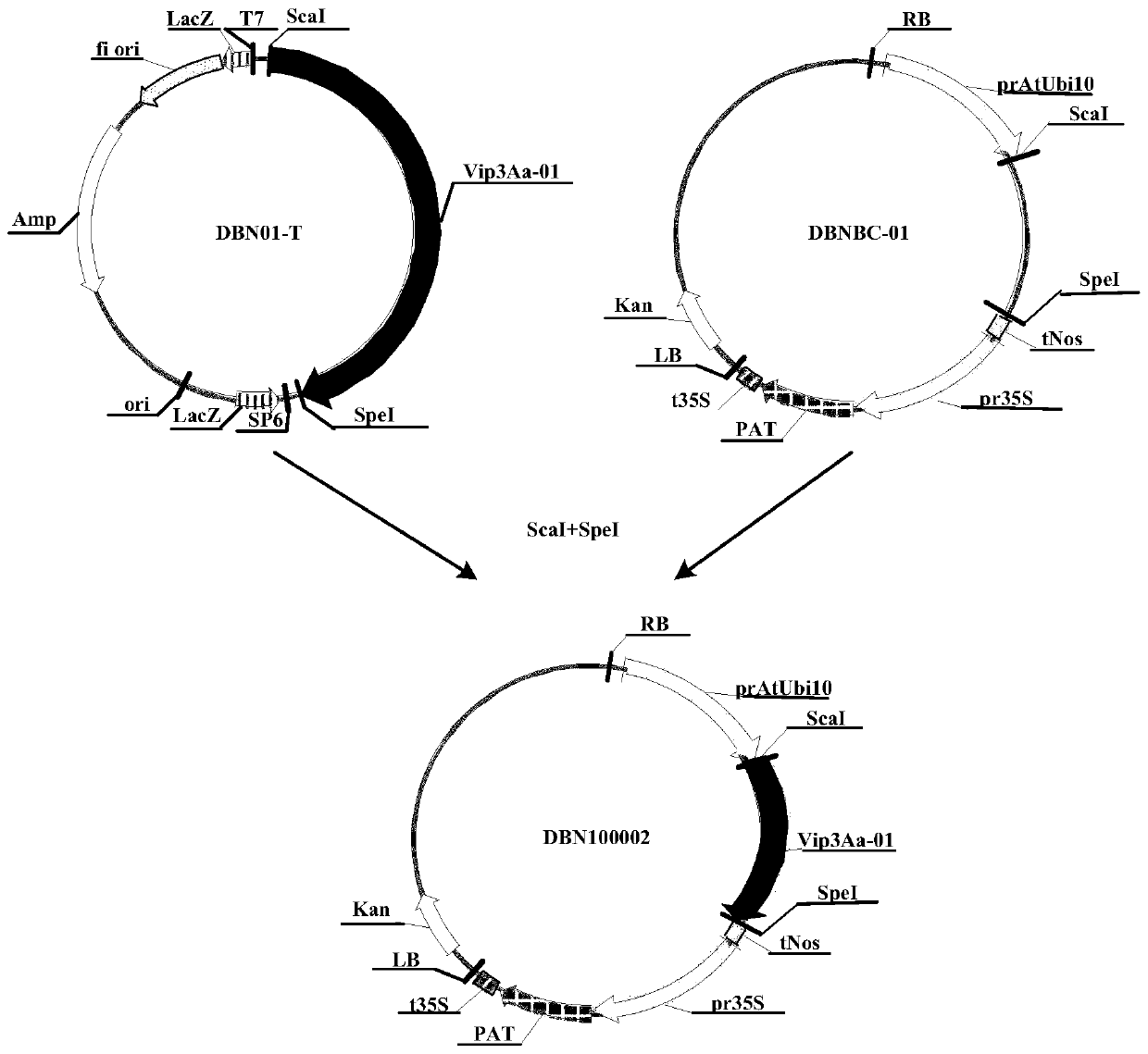Application of insecticidal protein
A protein and pest technology, applied in the field of insecticidal protein
- Summary
- Abstract
- Description
- Claims
- Application Information
AI Technical Summary
Problems solved by technology
Method used
Image
Examples
no. 1 example
[0085] The first embodiment, gene acquisition and synthesis
[0086] 1. Obtain the nucleotide sequence
[0087] The amino acid sequence (789 amino acids) of the Vip3Aa-01 insecticidal protein is shown in SEQ ID NO:1 in the sequence table; the nucleotide sequence of Vip3Aa-01 encoding the amino acid sequence of the Vip3Aa-01 insecticidal protein ( 2370 nucleotides), as shown in SEQ ID NO: 2 in the sequence listing.
[0088] The amino acid sequence (789 amino acids) of the Vip3Aa-02 insecticidal protein is shown in SEQ ID NO: 3 in the sequence table; the Vip3Aa-02 nucleotide sequence encoding the amino acid sequence of the Vip3Aa-02 insecticidal protein ( 2370 nucleotides), as shown in SEQ ID NO: 4 in the sequence listing.
[0089] The amino acid sequence (789 amino acids) of the Vip3Aa-03 insecticidal protein is shown in SEQ ID NO: 5 in the sequence table; the nucleotide sequence of Vip3Aa-03 encoding the amino acid sequence of the Vip3Aa-03 insecticidal protein ( 2370 nucleotides), ...
no. 2 example
[0095] The second embodiment, construction of recombinant expression vector and transformation of Agrobacterium with recombinant expression vector
[0096] 1. Construct a recombinant cloning vector containing Vip3Aa gene
[0097] Connect the synthesized Vip3Aa-01 nucleotide sequence to the cloning vector pGEM-T (Promega, Madison, USA, CAT: A3600), and proceed according to the instructions of Promega product pGEM-T vector to obtain the inverted recombinant cloning vector DBN01- T, its construction process is as figure 1 As shown (where Amp represents the ampicillin resistance gene; flori represents the origin of replication of phage fl; LacZ is the actual codon of LacZ; SP6 is the SP6 RNA polymerase promoter; T7 is the T7 RNA polymerase promoter; Vip3Aa-01 is Vip3Aa-01 nucleotide sequence (SEQ ID NO: 2); MCS is the multiple cloning site).
[0098] Then the recombinant cloning vector DBN01-T was transformed into E. coli T1 competent cells (Transgen, Beijing, China, CAT: CD501) by the ...
no. 3 example
[0115] The third embodiment, the acquisition of transgenic plants
[0116] 1. Obtain genetically modified soybean plants
[0117] According to the conventional Agrobacterium infection method, the cotyledonary node tissue of the aseptically cultured soybean variety Zhonghuang 13 was co-cultured with the Agrobacterium described in 3 in the second embodiment to replace the recombinant T-DNA expression vectors DBN100002, DBN100741, DBN100742, DBN100743, DBN100003 and DBN100370 (including the promoter sequence of the Arabidopsis ubiquitin gene, the nucleotide sequence of Vip3Aa-01, the nucleotide sequence of Vip3Aa-02, the nucleotide sequence of Vip3Aa-03 Nucleotide sequence, Vip3Aa-04 nucleotide sequence, Vip3Aa-02-Cry1Ab nucleotide sequence, Vip3Aa-01-Cry2Ab nucleotide sequence, PAT gene and tNos terminator sequence) were transferred into the soybean genome, and obtained Soybean plants transformed with the nucleotide sequence of Vip3Aa-01, soybean plants transformed with the nucleoti...
PUM
 Login to View More
Login to View More Abstract
Description
Claims
Application Information
 Login to View More
Login to View More - R&D
- Intellectual Property
- Life Sciences
- Materials
- Tech Scout
- Unparalleled Data Quality
- Higher Quality Content
- 60% Fewer Hallucinations
Browse by: Latest US Patents, China's latest patents, Technical Efficacy Thesaurus, Application Domain, Technology Topic, Popular Technical Reports.
© 2025 PatSnap. All rights reserved.Legal|Privacy policy|Modern Slavery Act Transparency Statement|Sitemap|About US| Contact US: help@patsnap.com



